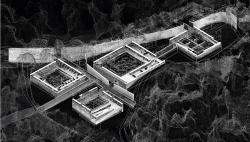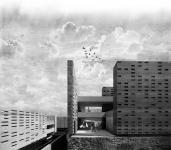Santa Bárbara is a neighborhood located on the Santa Bárbara Hill in Sogamoso, Boyacá, Colombia. It is characterized by being an urban-rural border and for having significant landmarks for the city: the Santa Bárbara chapel and the old aqueduct system. This was one of the first neighborhoods to emerge in the city following the Spanish conquest. Initially, it was one of the most important places in the area, as it is even located within the polygon of the historic center of Sogamoso. However, Santa Bárbara was consumed by neglect, becoming a haven for insecurity, violence, inequality, and substance abuse. A few years ago, the community joined forces to fight against all the problems that affected this historic place. Because of this, today Santa Bárbara is experiencing a revival in Sogamoso thanks to the efforts of its residents, who work daily to make this wonderful place shine again with the strength it once had.
Nevertheless, despite the great efforts of its inhabitants, Santa Bárbara continues to be stigmatized by gender, economic, and environmental violence. This is why the development of this project arises. It arises from the search for solutions to address various social, environmental, and economic responsibilities.
WALLS: Resignifying Vestiges, as its name suggests, begins by understanding the history, comprehending each of the historical elements that the place still preserves. The vestiges in Santa Bárbara are understood as the third landscape, the territory that was once used and exploited but has now been abandoned. This third landscape is the ruin, the aqueduct system that once served to supply Sogamoso with water brought from Monguí. Today, this aqueduct is no longer in use, leaving traces of its infrastructure to remind us that Santa Bárbara was once a source of fresh water for Sogamoso. This is why the vestiges are understood as walls, walls that are pierced, walls that connect, underground walls, surface walls, walls that degrade, walls of different sizes.
To begin with, Santa Bárbara is understood as a boundary, the boundary between the city's orthogonality and the organic nature. A boundary between urban and rural, order and chaos. Therefore, different questions arise: How should an urban-rural border respond to generate connections between two segmented areas? For this reason, the wall is understood as that element that, while having the ability to define and delimit spaces, can also blur the boundaries of the city.
For this reason, the project is composed of walls. The tanks of the old aqueduct system are understood as pre-existing elements that can function as a 4x1 and 1x4 system, where the vestige can be seen as a unit with its own program or together giving rise to different systems. The first system developed is the hydraulic one. This aims to re-naturalize the ecosystem by reactivating the aqueduct. Therefore, the first tank will extract groundwater that will enter the system and pass to tank 2. There, it will be treated through natural filters and slowed down before passing to tank 3 for treatment and storage, finally reaching the fourth tank for infiltration into aquifers. The remaining water will recharge the river formed in the floodable area around the aqueduct system. The second system is economic. The first tank will handle raw materials, with crops. The second tank is for production and will have a gender and differential focus. On the first level, care work will be carried out, the second level will be formative, and the third level will be paid work. This tank will not only consider single mothers but also elderly people who do not have access to a pension or decent work. The third tank is for marketing, with temporary exhibitions and galleries to display products produced in the previous tanks. The last tank is an exhibition space, which will function as a vertical theater for cultural events, community meetings, and commercial fairs.
The last system is solar, which, thanks to the configuration of the façade perforations, will have a special lighting effect on certain dates of the year in each of the tanks. Therefore, temporality is crucial in the project. In the first tank, a special lighting event will occur on July 17th, the date of the Sun and Steel festivities. The second tank will have an event on August 7th, commemorating the Battle of Boyacá. The third tank will celebrate September 6th when Sogamoso was recognized as a republican town. The fourth tank will have an event on December 21st, the winter solstice. Temporality will change the façade, as over time, the perforations are expected to provide habitat for various forms of life. This will turn the wall into a living wall that, through the façade configuration, which will go hand in hand with the vegetation that develops, will allow for different experiences, giving rise to a great matrix of operational crossroads that will make spaces and experiences different.
This is how WALLS: Resignifying Vestiges responds to the social, environmental, cultural, and economic needs of Santa Bárbara.
2023
The wall is the fundamental structural element of the project, composed of reinforced concrete. The wall represents the preexistence, the origin of the composition of memory. The vestiges found on the site are weathered concrete walls that have taken on different forms of life, revealing the traces of what happened in that place. Therefore, the project is built upon walls that express boundaries, that thin line that thickens, fragments, and perforates. This element shapes the facade of each of the tanks that make up the aqueduct system. Reinforced concrete allows the perforations made to be structural, so the parametric configuration of the pattern of perforations never hinders its load-bearing capacity. Additionally, these perforations have different arrangements and inclinations that not only align with the activities of each space but also enable lighting events on special dates. Furthermore, in order to give prominence to the vestiges, the new walls feature a slight setback at ground level, creating a visual effect of separating from the ground to frame the preexistences. It is expected that, over time, these walls will wear down, and their perforations will function as habitats for different forms of life, thereby creating a dichotomy between the urban and the natural. This will allow light, its reflection in the water, wind, and the shadows generated by the configuration of the facade to constantly change the project's experience. Additionally, the interior spaces have metal beams of varying sections that are anchored to the walls to provide structural support for the floors and allow for open and flexible spaces for various spatial configurations.
Design: Paula Camacho
Tutors: Daniela Atencio, Claudio Rossi, Daniel Bonilla.
Walls: Re-signifying vestiges by Paula Andrea Camacho Rodríguez in Colombia won the WA Award Cycle 45. Please find below the WA Award poster for this project.

Downloaded 0 times.




















